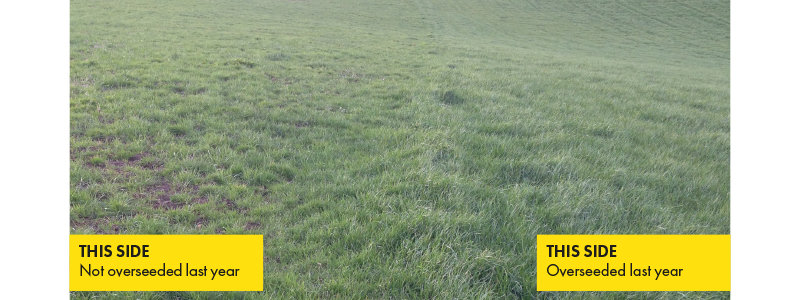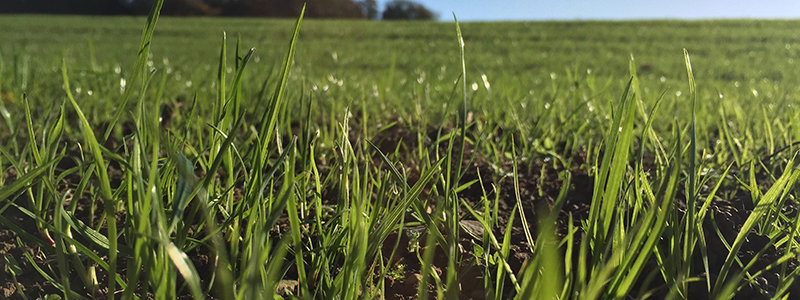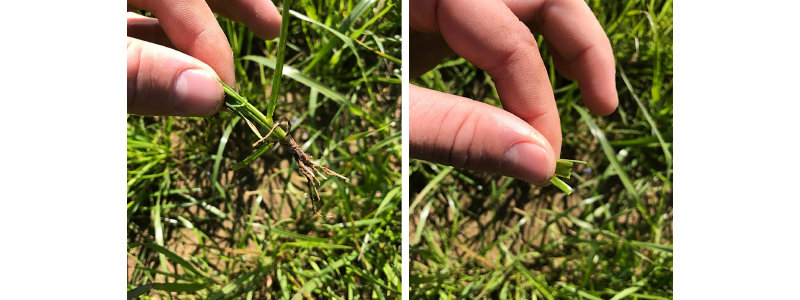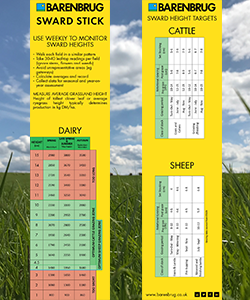Step 4 - Establish
Step 4, of our 4-step guide, covers overseeding, reseeding, and managing your grassland.
Missed Step 1 -3? Revisit these essentials grassland management stages.

Step 4, of our 4-step guide, covers overseeding, reseeding, and managing your grassland.
Missed Step 1 -3? Revisit these essentials grassland management stages.
Choosing whether to go for a full reseed or to overseed can feel like another difficult decision - so feel free to use our field indexing system as a guide.
Generally we suggest that:
Field Indexing 2 – 4 = overseeding
Field Indexing 1 = reseeding
Remind yourself of Step 1, which includes the field indexing system
A selection of information guides and advice to help you with grassland management. Click below to skip to the section
First graze & cut after seeding
Seven Habits Of Highly Effective Grassland Management
Don’t be afraid of overseeding - A short- to medium-term fix
Currently only around 2% of UK grassland is being oversown. Overseeding is a short- to medium-term option but it does provide a quick fix and is ultimately an effective method of improving productivity - while keeping investment costs to a minimum.
Overseeding is ideal for farmers who need to improve grassland performance to help boost profits but, understandably, feel nervous about investing in a full reseed or taking a field out of rotation.
While brand new swards will always outperform older grasses, overseeding can help to increase dry matter yields short-term – reducing farm reliance on expensive bought-ins and even improving live weight gains. Implemented carefully, overseeding has the potential to improve pasture productivity by between 30 to 40% for between three to four years, depending on field quality.
When overseeding, it is crucial to use a mixture designed specifically for this purpose. Any existing productive grasses in the ley already have an established root system and an established leaf canopy to capture light for photosynthesis. Any new grass seed that is introduced needs to be able to work with these conditions and overseeding mixtures are blended accordingly. Typically, they contain tetraploid perennial ryegrass varieties whose seeds are larger, have more aggressive growth habits and are faster to establish within an existing sward. As well as tetraploid-based varieties, introducing clover could be another option.
Clover can fill in gaps to reduce weed ingress. It can also improve nitrogen levels – encouraging tillering, which makes swards denser. Crucially, clover can also encourage higher voluntary intakes, improving live weight gains.

For fields beyond repair and needing rejuventation.
Reseeding grassland can feel like a major investment, especially if you’ve got a big farm, but you shouldn’t underestimate its importance. Did you know that in order to just ‘stand still’ in terms of grass quality, you should, ideally, reseed a minimum of 10% of your grass every year! While a 15% reseeding rate will start to deliver real gains - and make a difference to your bottom line. Conversely, fields that are not reseeded will quickly become overrun with weed species with little or no nutritional value.
Dig a soil assessment pit to look for compaction and plant rooting structure, which should go 30cm deep in a perennial ryegrass/ Timothy sward.
Address compaction with aerators or sub-soilers as needed.
Soil testing (4” deep) would also be advantageous as high levels of water can leach nutrients and reduce pH significantly.
Assess what plants are there – learn to identify what species you want to have e.g. perennial ryegrass/Timothy. Check for weed grasses,
they are usually shallow rooted and pull out very easily.
If they make up more than 30% of the sward, harrow hard to remove them.
With a sward of more than 70% weed grasses the best option is to reseed the sward.
Minimise competition to new seedlings by grazing tightly with sheep or taking a silage cut. DO NOT fertilise before overseeding.
Control perennial weeds before seeding by spraying with a selective herbicide.
Use a spring tine harrow to remove any dead stalks, thatch and shallow rooted weed grasses. Make sure that the tines are working the top 1cm of the soil as this will create the seed bed for the new seeds.
Choose a grass seed mixture designed for the job.
Sow when the soil conditions are neither excessively dry nor wet and use a specialist mixture designed to establish rapidly.
Roll the sward to ensure good seed contact with the soil to conserve moisture.
Graze lightly when the seedlings are 10cm high and continue at frequent intervals until the plants are well established.
After seeding your field, you should consider this ley as ‘establishing’ for the first 12 months. Many new leys achieve high DM yields in the first year, even though their rooting structures are often poor and management during the first year is critical to achieve longer-term persistency of growth and performance.
The better the underground rooting system, the better the plants are able to withstand future adversity.
Generally, but not always, the more cover there is, the better established the grass sward.
Cherish new swards like growing young stock – they are the production house of the future.

Knowing when to graze grass and for how long requires careful judgement and it is wise to conduct regular visual checks of the number of tillers present to avoid problems.
GRAZING TOO EARLY
On a new ley, grazing grass too early – before a second new tiller leaf appears – can damage grass persistency. If a plant’s reserves have not been fully restored, future growth will be in jeopardy. Repetitive early grazing can permanently decrease grassland yield and persistence. Grazing grasslands at the right time is especially important through dry summer periods when plants are under stress; grazing the first new growth after a period of drought and before a tiller has two and a half new leaves in place can kill grass.
GRAZING TOO LATE
If grassland is left to grow too long (>3500 kg DM / ha) it will enter the ceiling phase of grassland growth. In this phase, tillers continue to produce new leaves, however, there is no further increase in net grassland mass due to the dying off of older leaves. If grassland isn’t grazed, dead material, which has little feed value, will build up in the base of sward.
This can lead to:

TRY THE PLUCK TEST.
Grasp the ryegrass seedling firmly between your thumb and forefinger, then tug
in a single, quick movement (to mimic an animal biting). If the leaves break off and the roots stay in the ground, the pluck test is passed.
In the photos above:
Left: Roots being pulled from ground
Right: Leaves breaking = a good time to start the first grazing.
The role of first grazing is to stimulate tillering and allow light to the base of the sward, enabling clover to flourish.
Remember:
A weed is “a plant in the wrong place”, but weeds can have significant consequences for grass leys. For example, where a field contains a 20% dock infestation, this can equate to a loss in 20% of potential grass production. This is due to the persistence of weeds competing for light, nutrients and moisture. Many weeds will thrive in newly sown leys with less competition. Weeds also love land with poorer soil conditions.
Tackling weeds is essential as they can:
The UK’s grassland is always deficient in nitrogen (N), which assists with the tillering of ryegrass plants as well as overall grass health. In a new sward, a clover component will not contribute N immediately - so it is important to add fertiliser. New grass responds well to regular, light applications of N.
Knowing when to graze grass and for how long requires careful judgement. To help farmers gauge when to graze grass, we’ve developed a brand new sward stick, which is available completely free of charge. Printed with the optimum heights for grass for both sheep and beef, our sward stick is designed to help growers decide when to turn livestock out, and when to adjust grazing pressure.
We recommend using sward sticks on a weekly basis – to build up a log of grass growing information. Farmers should walk each relevant field, once a week, to monitor sward height. Following a similar route each time, they should take 30 to 40 leaf-top readings per field – before calculating an average and recording it in a notebook. This information can then be used to aid decision-making and for longer-term seasonal and year-on-year assessments and adjustments. We’ve created sward sticks in the past and they’ve proved really popular so make sure you get hold of yours quickly.
Order your FREE Sward Stick here
